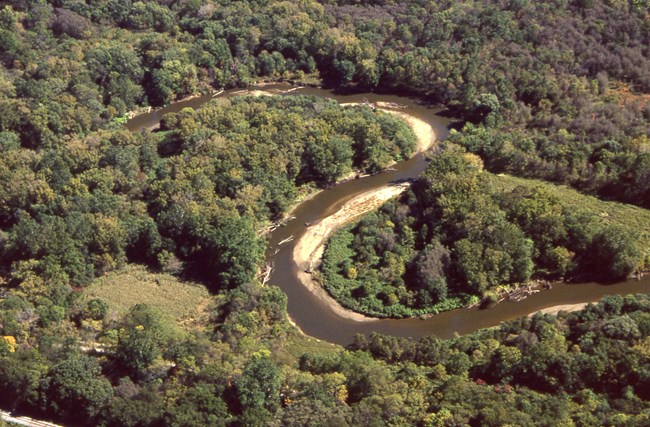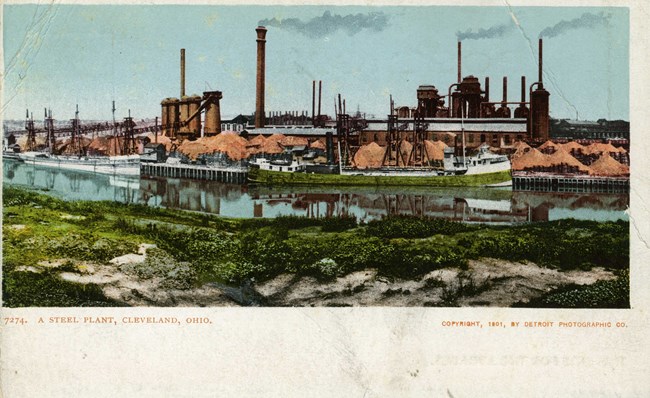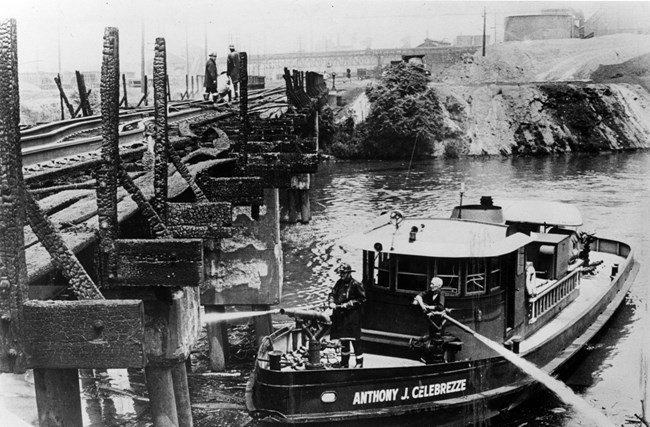Last updated: July 10, 2023
Article
The Cuyahoga, a National Heritage River

NPS / Robert George
The Cuyahoga River has kept itself on history’s pages. It has been a transportation route; a boundary; a birthplace for oil, rubber and modern steel industries; a power source; and a dumping place. Although small in size, it became a national icon, starting with a famous fire in 1969. This galvanized the environmental movement and helped lead to the establishment of the Environmental Protection Agency (EPA) and passage of the Clean Water Act. Because of the Cuyahoga, rivers throughout the nation are better monitored and protected.

NPS Collection
Crooked Path
The 100-mile Cuyahoga River flows both south and north before emptying into Lake Erie at Cleveland, Ohio. This is a scant 30 miles west of its headwaters. American Indians called it “Ka-ih-ogh-ha”—crooked. This U-shaped path is due to the river’s geologic history. As melting glaciers retreated from the last ice age, their waters tried to find their way to Lake Erie. They wandered south until they hit a north-south continental divide. At what is now Akron, they turned sharply north and burrowed into an ancient river bed filled with glacial debris. Today the river drains 813 square miles of land in portions of six counties. The Cuyahoga has rural beginnings in Geauga County, yet its lower river basin is one of the most densely populated and industrialized urban areas in North America.

NPS / Midwest Archeological Center
History of Commerce
The importance of the Cuyahoga River to people begins with the American Indians who used it for thousands of years in their trade routes that reached throughout much of North America. Indians could leave the Cuyahoga River and portage eight miles overland on the old Portage Path through Akron to connect to the Tuscarawas watershed, the Ohio River, and the Mississippi River.
By the 1600s, the Cuyahoga appeared on maps and in Jesuit records of the region. In 1795, the Treaty of Greenville established the Cuyahoga River as the northernmost boundary between the United States and Indian territory. This distinction ended ten years later when the Treaty of Fort Industry pushed the boundary west. As the young nation expanded, settlers moved to the lands known as the Western Reserve which surrounded the river. Living here was initially a challenge because it was hard to move people and goods, and malaria was common. Men of vision foresaw the vast Ohio country’s potential, if only transportation could be improved. The river, falling some 395 feet in 38 miles, was unsuitable for transportation, but its water could be used to fill a more reliable system: the Ohio & Erie Canal. Cash and commerce began flowing when the canal opened between Akron and Cleveland in 1827.

NPS Collection
The canal’s unique location alongside the river’s 180-degree turn and rapid fall soon brought industrialization to Northeast Ohio. Cleveland was at the crossroads of iron ore, coal, and the confluence of the Cuyahoga River and Lake Erie, making it attractive to industrialists such as John D. Rockefeller who founded Standard Oil there. Akron’s unique lofty position on the divide between the Gulf of Mexico and the Great Lakes gave it water power that brought industries such as Ferdinand Schumacher's oats and Benjamin F. Goodrich’s rubber.

Cleveland Public Library
Flames Spark a Movement
Industrialization came at a cost. The Cuyahoga River began to transport industry’s waste and the growing cities’ sewage. As early as 1863, the river was recorded as muddy and murky in Cleveland. The Cuyahoga is now famous as the river that burned, but few realize how early and often it did so: in 1868, 1883, 1887, 1912, 1922, 1936, 1941, 1948, and 1952. The latter caused nearly $1.5 million in damage.

Arrye Rosser Collection
However, it was the June 22, 1969 fire that helped galvanize the national environmental movement. Ironically, this fire was modest in scale and initially attracted little attention. A railroad trestle near the river’s mouth caused debris such as floating logs and picnic benches to pile up. A flare tossed from a passing train likely provided the spark that ignited both the debris and the oil floating on the water. The fire burned only 24 minutes—too quick for the Cleveland Plain Dealer to get a photograph. Fame came later when Time magazine ran an article about the incident in its August 1 issue, widely read because of the cover story on the Chappaquiddick scandal. The article described the Cuyahoga as the river that “oozes rather than flows” and in which a person “does not drown but decays.” This, coupled with an oil spill in California that year, became rallying cries for America to protect its waterways.
The event helped spur an avalanche of pollution control activities resulting in the Water Quality Improvement Act of 1970, the Clean Water Act of 1972, the Great Lakes Water Quality Agreement, and creation of state and federal Environmental Protection Agencies. The historical significance of the Cuyahoga River was recognized in 1998 when it was designated an American Heritage River.
The story continues with The Cuyahoga’s Comeback.
